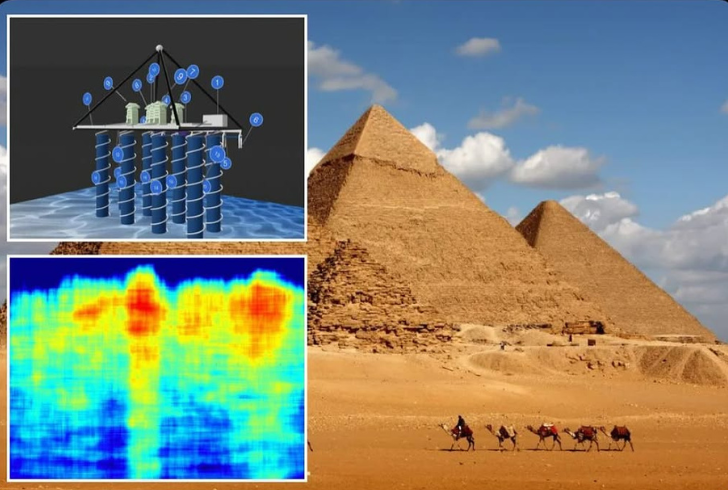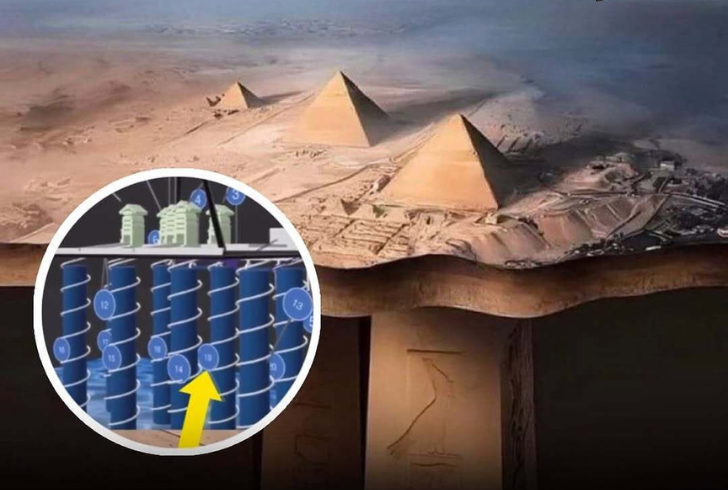A remarkable discovery beneath the Egyptian pyramids has captivated researchers and history enthusiasts alike. According to Italian scientists, an underground city might be hidden beneath the iconic Pyramids of Giza. If confirmed, this revelation could significantly alter the understanding of ancient Egyptian civilization.
Radar Technology Unveils an Underground Network
A recent study utilized advanced radar pulses to generate high-resolution images of the ground beneath the Giza pyramids. Similar to sonar mapping used in ocean exploration, this technology detected eight vertical cylinder-shaped structures extending over 2,100 feet underground. Even more astonishing, the data suggested unknown structures stretching 4,000 feet deeper, possibly forming a vast underground system.
However, despite the excitement surrounding these findings, the study has not yet undergone peer review by independent experts. Many archaeologists remain skeptical, questioning whether the technology used can truly penetrate such depths.
Skepticism From Experts and the Need for Verification
While the discovery is groundbreaking, some experts argue that radar technology cannot reach such extreme depths. Professor Lawrence Conyers, a ground-penetrating radar specialist from the University of Denver, expressed serious doubts. He explained that while small underground chambers could exist, the idea of a fully developed subterranean city is highly exaggerated.
He also pointed out that many ancient cultures built significant structures over natural caverns. The Mayans, for instance, often constructed pyramids over caves with ceremonial significance. If a similar pattern existed in ancient Egypt, it might explain the mysterious underground formations.

Instagram | therealstateofamerica | Radar technology reveals hidden structures under pyramids.
Who Conducted the Study?
The study was led by Corrado Malanga from Italy’s University of Pisa, along with Egyptologist Armando Mei and Filippo Biondi from the University of Strathclyde in Scotland. Their findings were announced at a recent conference in Italy, though the research has yet to be published in a scientific journal.
Notably, Malanga has previously been associated with UFO studies, raising further skepticism. However, Biondi is recognized for his expertise in radar technology, and Mei specializes in pre-dynastic Egyptology, adding credibility to the research.
Could This Discovery Change Ancient Egyptian History?
If proven accurate, this underground network could be one of the most significant archaeological discoveries in modern times. The research suggests that a vast system of chambers and tunnels might connect all three pyramids—Khufu, Khafre, and Menkaure—potentially serving unknown purposes.
Some scholars have linked these findings to the legendary Halls of Amenti, an ancient Egyptian myth describing a hidden chamber of knowledge. However, without physical excavation, it remains unclear whether these structures exist as described.
What Makes the Pyramids of Giza So Mysterious?
The Giza pyramid complex, built over 4,500 years ago, continues to be one of the world’s greatest architectural wonders. Each of its three pyramids was constructed for a different pharaoh:
1. Khufu’s Pyramid (The Great Pyramid) - The largest, standing at 480 feet tall, with a base width of 750 feet.
2. Khafre’s Pyramid - Slightly smaller but known for its intact limestone casing at the top.
3. Menkaure’s Pyramid - The smallest, yet still an impressive engineering feat.
For centuries, researchers have speculated that hidden chambers or tunnels could be concealed beneath these massive structures. This new study adds further intrigue to those theories.
How Was This Study Conducted?
The researchers used satellite radar technology combined with natural seismic vibrations to create 3D images of the underground formations. Unlike traditional excavation, this method allows scientists to explore subsurface structures without disturbing the site.
According to Nicole Ciccolo, the study’s spokesperson, the radar detected cylinder-shaped structures arranged in parallel rows beneath each pyramid. Surrounding these formations, researchers identified spiral pathways that might serve as access points to a larger underground network.
Previous Research Supports the Possibility of Hidden Chambers

Instagram | ancientexplorers | Researchers discover possible hidden chambers under pyramids.
This is not the first time anomalies beneath the pyramids have been detected. In October 2022, Malanga and Biondi published a peer-reviewed study in the scientific journal Remote Sensing. Their research identified hidden ramps and chambers inside Khafre’s Pyramid, along with thermal anomalies near its base.
These findings align with earlier discoveries suggesting undocumented voids within the pyramids. Some archaeologists believe these empty spaces might contain burial chambers or storage areas, though no conclusive evidence has been found.
A Sensationalized Claim?
While the study’s claims are fascinating, many experts urge caution. Without physical excavation, the presence of a full-scale underground city remains speculative.
Professor Conyers emphasized that radar signals cannot accurately penetrate thousands of feet below ground. He suggested that only targeted excavations could verify whether the formations detected are man-made structures or natural geological formations.
What’s Next?
The research team plans to continue investigations through 2025 to refine their findings. Egyptologists may need to reassess long-held theories about the pyramids’ construction and purpose if future studies confirm these underground formations.
For now, the possibility of a hidden city beneath the pyramids remains an enticing mystery, capturing the world’s imagination and fueling ongoing debates among archaeologists and historians.
Even while modern technology continues to uncover previously undiscovered facets of Egypt's history, on-site digs are the only way to validate these discoveries. In the meantime, the world observes as scientists work to uncover the ancient mysteries of the pyramids.
